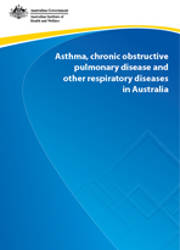Summary
In 2007–08, general practitioners managed respiratory problems more than any other condition (19% of all encounters) and in 2006, diseases of the respiratory system were the third most common underlying causes of death (8%). In 2004–05, Australia spent $3.3 billion directly on respiratory diseases, making this the sixth highest disease expenditure group.
This report presents the epidemiology of each of the main respiratory diseases and highlights their differences and similarities.
Major findings for each respiratory condition are:
Asthma affected 10% of all Australians (over 2 million people) and 16% of Indigenous Australians in 2004–05. The highest prevalence was among those aged less than 25 years. Asthma is one of the most frequent reasons for hospitalisation of children aged 0–4 years, especially boys.
Hay fever and chronic sinusitis share causative agents with asthma and are often found together. About 3.2 million Australians reported they had hay fever as a long-term condition in 2004–05 and about 1.8 million people reported having chronic sinusitis.
Chronic obstructive pulmonary disease (COPD) is a disease that affects older people more than younger, and males more than females. Most COPD cases are attributable to a history of tobacco smoking. In 2006, 4,761 deaths (4% of the total deaths in Australia) had COPD as an underlying cause. In Australia, a steady decline in tobacco consumption, beginning in the 1970s, has been reflected 15 years later by a steady decline in COPD-related deaths. Hospital separation rates for COPD declined from 258 per 100,000 people in 1998–99 to 241 in 2006–07.
Influenza and pneumonia can worsen symptoms for people with chronic respiratory diseases and lead to serious consequences. Influenza or pneumonia were the underlying causes of 2,715 deaths in 2006, 2% of all deaths in that year. In addition, there were 14,069 deaths where influenza or pneumonia were considered contributory. Influenza and pneumonia were reported as the principal diagnoses during 61,014 stays in hospital in 2006–07.
Bronchiectasis rarely appears in isolation from other respiratory conditions. It is more common in women than men, and more common in older age groups and in Indigenous Australians. In 2006–07, bronchiectasis was the principal diagnosis for 4,019 hospitalisations (1.2% of all respiratory hospitalisations). In addition, there were 8,489 hospitalisations where bronchiectasis was an additional diagnosis.
Cystic fibrosis (CF) is Australia’s most common inherited recessive genetic condition, affecting 2,472 Australians in 2005. There has been a decline in the incidence of CF and a downward trend in CF deaths over the past 9 years.
Pneumoconiosis affects the lungs and results from inhaling certain dusts. It includes the conditions silicosis and asbestosis. Deaths due to pneumoconiosis have become less common since the early 1950s—dropping from 3.9 deaths per 100,000 people in 1950 to 1 per 100,000 people in 2006. In 2006–07, 90% of the 213 pneumoconiosis hospitalisations were for males.
Sleep apnoea (SA) causes impaired mental processes, increased risk of motor vehicle accident and aggravates cardiovascular conditions. It is estimated that 26% of 40 to 65 year old men have SA. SA related death rates have increased steadily from 0.8 to 1.3 per 100,000 population from 1998 to 2006. In 2006–07, there were approximately 44,500 SA hospitalisations.
Preliminary pages: Acknowledgments; Abbreviations
Introduction
- The respiratory system and disease
- Diseases covered
- Relationships between respiratory diseases
- The monitoring of respiratory diseases in Australia
- Report structure
- Notes on terms used in this analysis
Respiratory disease risk and trigger factors
- Genetic susceptibility
- Behavioural factors
- Indoor allergens and air pollutants
- Outdoor allergens and air pollutants
- Occupational exposures
- Dietary factors
- Excess body weight
- Infectious diseases
Asthma
- General epidemiology
- Health service impacts
- Comorbidities and complicating factors
Hayfever (allergic rhinitis)
- General epidemiology
- Health service impacts
Chronic sinusitis
- General epidemiology
- Health service impacts
- Comorbidities and complicating factors
Chronic obstructive pulmonary disease
- General epidemiology
- Health service impacts
- Comorbidities and complicating factors
Influenza and pneumonia
- Influenza
- Pneumonia
- General epidemiology
- Health service impacts
- Comorbidities and complicating factors
Bronchiectasis
- General epidemiology
- Health service impacts
- Comorbidities and complicating factors
Cystic fibrosis
- General epidemiology
- Health service impacts
- Comorbidities and complicating factors
Pneumoconiosis
- Causes of pneumoconiosis
- General epidemiology
- Health service impacts
Sleep apnoea
- General epidemiology
- Health service impacts
- Comorbidities and complicating factors
Appendixes
Appendix A: Source tables
Appendix B: Health care expenditure
Appendix C: Fact sheets
End matter: References; List of tables; List of figures; List of boxes



